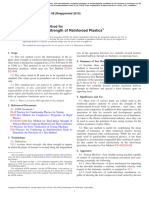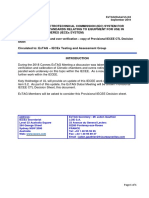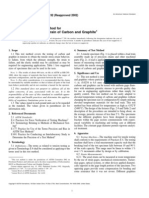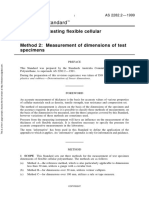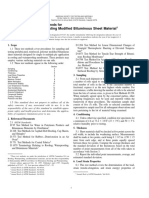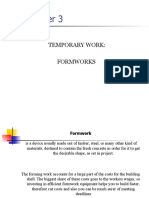440 3R-12Table1 3
440 3R-12Table1 3
Uploaded by
16562306Copyright:
Available Formats
440 3R-12Table1 3
440 3R-12Table1 3
Uploaded by
16562306Original Title
Copyright
Available Formats
Share this document
Did you find this document useful?
Is this content inappropriate?
Copyright:
Available Formats
440 3R-12Table1 3
440 3R-12Table1 3
Uploaded by
16562306Copyright:
Available Formats
4 FRP COMPOSITES FOR REINFORCING OR STRENGTHENING CONCRETE AND MASONRY STRUCTURES (ACI 440.
3R-12)
Table 1.3—Test methods for FRP composites used in concrete and masonry structures
ASTM test ACI 440 test
Property method(s) method Summary of differences
Cross-sectional area D7205/D7205M — ASTM D7205/D7205M replaces ACI 440.3R-04 Method B.1.
Longitudinal tensile strength and
D7205/D7205M — ASTM D7205/D7205M replaces ACI 440.3R-04 Method B.2.
modulus
ASTM Pullout Test C234 (ASTM C234) has been withdrawn and, as
written, did not provide adequate specimen size to prevent splitting of
concrete cylinder when using FRP bars.
Bond properties A944 B.3
The only remaining ASTM test method for bond of steel bars to concrete
is beam-end test method (A944), which has not been modified for use
with FRP bars. Ongoing work by ACI Committee 440 is expected to
produce beam bond test methods.
Shear strength D7617/D7617M — ASTM D7617/D7617M replaces ACI 440.3R-04 Method B.4.
Bent bar capacity — B.5 No existing ASTM test method available.
Durability properties — B.6 No existing ASTM test method available.
The ACI method provides specific information on anchoring bars in the
test fixtures and on attaching elongation measuring devices to the bars.
Fatigue properties D3479 B.7
The ACI method also requires specific calculations that are not provided
in the ASTM method.
Creep properties D7337/D7337M — ASTM D7337/D7337M replaces ACI 440.3R-04 Method B.8.
D2990 The ACI method provides specific information on anchoring bars in the
test fixtures and on attaching elongation measuring devices to the bars.
Relaxation properties B.9
E328 The ACI method also requires specific calculations that are not provided
in the ASTM method.
Anchorage properties — B.10 No existing ASTM test method available.
Tensile properties of deflected bars — B.11 No existing ASTM test method available.
Effect of corner radius on strength — B.12 No existing ASTM test method available.
D790
Flexural properties — No ACI method developed.
D4476
E831
Coefficient of thermal expansion (CTE) — No ACI method developed.
D696
E1356
E1640
Glass transition temperature — No ACI method developed.
D648
E2092
D3171
Volume fraction — No ACI method developed.
D2584
Direct tension pulloff D7522/D7522M — ASTM D7522/D7522M replaces ACI 440.3R-04 Method L.1.
Tensile strength and modulus D7565/D7565M — ASTM D7565/D7565M replaces ACI 440.3R-04 Method L.2.
Lap shear strength D7616/D7616M — ASTM D7616/D7616M replaces ACI 440.3R-04 Method L3.
D4551
Bond strength — No ACI method developed.
C882
FRP bar—composite
r material formed into a long, slender, FRP tendon—FRP element, such as a bar or strand, or a
structural shape suitable for the internal reinforcement of bundle of such elements primarily used in tension to impart
concrete and consisting of primarily longitudinal unidi- compressive stress to concrete or masonry.
rectional fibers bound and shaped by a rigid polymer resin gauge length—distance between two gauge points on
material. The bar may have a cross section of variable shape, the test section, over which the percentage of elongation is
commonly circular or rectangular, and may have a deformed determined.
or roughened surface to enhance bonding with concrete. glass fiber—fiber drawn from an inorganic fusion of
FRP laminates—two or more layers of fiber reinforce- silica (SiO2) and other compounds that has cooled without
ments, such as, glass, carbon, and aramid arranged in one or crystallization.
more orientations—for example, 0, 90, +45, –45 degrees— grid—two-dimensional (planar) or three-dimensional
and held together by a polymer matrix. Laminates come in (spatial) rigid array of interconnected FRP bars that form
the physical form of dry, prepreg, and precured materials. a contiguous lattice that can be used to reinforce concrete.
Note: The lattice can be manufactured with integrally
American Concrete Institute Copyrighted Material—www.concrete.org
You might also like
- Astm F2170Document7 pagesAstm F2170AhmedNo ratings yet
- Tennis Court Constructions GuideDocument30 pagesTennis Court Constructions Guidetalent1968100% (1)
- Iso 13383 1 2012 en PDFDocument11 pagesIso 13383 1 2012 en PDFponorNo ratings yet
- Tensile Bond TestDocument14 pagesTensile Bond TestPanneer SelvamNo ratings yet
- International Society For Rock Mechanics Commission On Testing MethodsDocument26 pagesInternational Society For Rock Mechanics Commission On Testing MethodsDavid Almanza PerezNo ratings yet
- Astm D 7957-17Document5 pagesAstm D 7957-17ibrahim bohilal100% (3)
- Name of System - LGSF With Fiber Cement Board On Both Sides Using Glass Wool InsulationDocument7 pagesName of System - LGSF With Fiber Cement Board On Both Sides Using Glass Wool InsulationNishan GajurelNo ratings yet
- Radius of CurvatureDocument11 pagesRadius of CurvatureLakshay100% (1)
- Density Testing and Inspection Manual: 2003 EDITION Revised December 2014Document99 pagesDensity Testing and Inspection Manual: 2003 EDITION Revised December 2014Paolo De PeraltaNo ratings yet
- E 986 - 04 (2010)Document3 pagesE 986 - 04 (2010)ruben carcamoNo ratings yet
- Iso 1183 1 2004Document18 pagesIso 1183 1 2004luciana :D50% (2)
- (Eng) ASTM D3846-08 Standard Test Method For In-Plane Shear Strength of Reinforced PlasticsDocument3 pages(Eng) ASTM D3846-08 Standard Test Method For In-Plane Shear Strength of Reinforced Plasticsjaehoon.ahnNo ratings yet
- Recommended Test Method: Nonwovens Mass Per Unit AreaDocument2 pagesRecommended Test Method: Nonwovens Mass Per Unit Area4033009323No ratings yet
- Astm F3299.23586Document4 pagesAstm F3299.23586Zohreh MosaferiNo ratings yet
- Certification To Standards Relating To Equipment For Use inDocument6 pagesCertification To Standards Relating To Equipment For Use ingopinadh57No ratings yet
- BS 2782-10 Method 1005 1977Document13 pagesBS 2782-10 Method 1005 1977Yaser ShabasyNo ratings yet
- Iso 7176-14Document62 pagesIso 7176-14diegosperaficoNo ratings yet
- Scaling Resistance of Concrete Surfaces Exposed To Deicing ChemicalsDocument3 pagesScaling Resistance of Concrete Surfaces Exposed To Deicing ChemicalsJesús Luis Arce GuillermoNo ratings yet
- Astm e 114 - 10Document5 pagesAstm e 114 - 10Martin Chimenti - ARO SANo ratings yet
- Astm 472 PDFDocument3 pagesAstm 472 PDFJOSEPH REFUERZONo ratings yet
- C179 - Test Method For Drying & Firing Linear Change of Refractory Plastic & Ramming Mix SpecimensDocument2 pagesC179 - Test Method For Drying & Firing Linear Change of Refractory Plastic & Ramming Mix SpecimensLech Ray Gomez CordobaNo ratings yet
- Iso 5085 1 1989Document9 pagesIso 5085 1 1989Zeeshan KhanNo ratings yet
- Tensile Stress-Strain of Carbon and Graphite: Standard Test Method ForDocument12 pagesTensile Stress-Strain of Carbon and Graphite: Standard Test Method Forsj19330No ratings yet
- B769 112021 2 02 Standard Test Method For Shear Testing of AluminumDocument4 pagesB769 112021 2 02 Standard Test Method For Shear Testing of AluminumShodji MabungaNo ratings yet
- AATCC 173 CMC:小色差合格率计算Document5 pagesAATCC 173 CMC:小色差合格率计算Fernando Carlos De la hoz TorresNo ratings yet
- SGS - Price List - Nov 2010 - Full - Up DatedDocument13 pagesSGS - Price List - Nov 2010 - Full - Up Datedabushahadat100% (1)
- Astm E340 23Document6 pagesAstm E340 23ARINDAM SETTNo ratings yet
- AstmDocument6 pagesAstmrenefbgNo ratings yet
- Lani 7060 - ASTM D5034Document1 pageLani 7060 - ASTM D5034Serdar KaçamerNo ratings yet
- As 2197-1978 Method For The Micrographic Assessment of The Non-Metallic Inclusion Content in Wrought SteelDocument6 pagesAs 2197-1978 Method For The Micrographic Assessment of The Non-Metallic Inclusion Content in Wrought SteelSAI Global - APAC0% (1)
- As 2282.2-1999 Methods For Testing Flexible Cellular Polyurethane Measurement of Dimensions of Test SpecimensDocument2 pagesAs 2282.2-1999 Methods For Testing Flexible Cellular Polyurethane Measurement of Dimensions of Test SpecimensSAI Global - APACNo ratings yet
- ASTM D5147 - Sampling and Testing Modified Bituminous Sheet Material1Document5 pagesASTM D5147 - Sampling and Testing Modified Bituminous Sheet Material1jothi vel muruganNo ratings yet
- Toaz - Info Astm c136 19 PRDocument5 pagesToaz - Info Astm c136 19 PRkhaleelNo ratings yet
- Is 12308-4 - 1988 - 2Document1 pageIs 12308-4 - 1988 - 2Svapnesh ParikhNo ratings yet
- Astm C31 C31M 23Document4 pagesAstm C31 C31M 23sahitawa8No ratings yet
- ASTM D2726 - 2019 - Bulk Specific Gravity and Density of Non-Absorptive Compacted Asphalt MixturesDocument4 pagesASTM D2726 - 2019 - Bulk Specific Gravity and Density of Non-Absorptive Compacted Asphalt MixturesTamanna JerinNo ratings yet
- Waste and Waste Management: Standard Terminology ForDocument18 pagesWaste and Waste Management: Standard Terminology ForFernanda MoralesNo ratings yet
- 16 CFR 1500.44Document2 pages16 CFR 1500.44Milagros WieczorekNo ratings yet
- Method For Mercurous Nitrate Test For Copper I and Copper Alloys (Document4 pagesMethod For Mercurous Nitrate Test For Copper I and Copper Alloys (Mukesh kumarNo ratings yet
- Iso 15835 2 2018Document9 pagesIso 15835 2 2018ranca992No ratings yet
- WSRL - SOP - 03 Fluorescent Ultraviolet (UV) Lamp Apparatus Exposure of Plastices - ASTM D4329-13 Report FormatDocument4 pagesWSRL - SOP - 03 Fluorescent Ultraviolet (UV) Lamp Apparatus Exposure of Plastices - ASTM D4329-13 Report Formatswapon kumar shillNo ratings yet
- Astm C792-15Document3 pagesAstm C792-15Lydia0% (1)
- D897 617621-1Document3 pagesD897 617621-1Fernando Cardeño LopezNo ratings yet
- Astm D7234 19Document4 pagesAstm D7234 19Jaime Benitez AlvarezNo ratings yet
- Galva PulseDocument4 pagesGalva PulseAlex CrispimNo ratings yet
- E83 16 PDFDocument14 pagesE83 16 PDFMiguel BazalduaNo ratings yet
- Astm c1090Document5 pagesAstm c1090ivanhermalNo ratings yet
- M47-16781-EN RevF - Impact TestingDocument48 pagesM47-16781-EN RevF - Impact TestingIvy LiNo ratings yet
- Force Verification of Testing Machines: Standard Practices ForDocument10 pagesForce Verification of Testing Machines: Standard Practices Forruben carcamoNo ratings yet
- Static Modulus of Elasticity and Poisson's Ratio of Concrete in CompressionDocument6 pagesStatic Modulus of Elasticity and Poisson's Ratio of Concrete in Compressionnolanjc100% (1)
- Iso 9863 1 2016Document9 pagesIso 9863 1 2016Samer MohamedNo ratings yet
- ISO 16163 - (2012) - (Continuos HDG-Dimensional and Shape-Tolerances) - 10pgsDocument10 pagesISO 16163 - (2012) - (Continuos HDG-Dimensional and Shape-Tolerances) - 10pgsdpfloresNo ratings yet
- Astm D365Document3 pagesAstm D365Frank LeeNo ratings yet
- As 1289.4.2.1-1997 Methods of Testing Soils For Engineering Purposes Soil Chemical Tests - Determination of TDocument2 pagesAs 1289.4.2.1-1997 Methods of Testing Soils For Engineering Purposes Soil Chemical Tests - Determination of TSAI Global - APACNo ratings yet
- ASTM G51-95 - Standard Test Method For Measuring PH of Soil For Use in Corrosion TestingDocument3 pagesASTM G51-95 - Standard Test Method For Measuring PH of Soil For Use in Corrosion Testingfrank.chapmanNo ratings yet
- Astm A706 A706m 22Document4 pagesAstm A706 A706m 22alvaradolu85No ratings yet
- Sist en Iso 10618 2004Document11 pagesSist en Iso 10618 2004Jerónimo Videla100% (1)
- Astm D790-03Document14 pagesAstm D790-03wahyuNo ratings yet
- Iso 6508-2Document17 pagesIso 6508-2Safae MashateNo ratings yet
- In Situ Stress and Modulus of Deformation Using The Flatjack MethodDocument7 pagesIn Situ Stress and Modulus of Deformation Using The Flatjack MethodValdo MendozaNo ratings yet
- Astm D5Document4 pagesAstm D5Esteban FinoNo ratings yet
- Tensile Strength Estimate by Disc Compression of Manufactured GraphiteDocument5 pagesTensile Strength Estimate by Disc Compression of Manufactured GraphitemsinanacikgozNo ratings yet
- Baja AleDocument14 pagesBaja AleMy JokeNo ratings yet
- Reinforcing Bar Couplers-UK-IRE-Edition June 2014 - Version 3Document28 pagesReinforcing Bar Couplers-UK-IRE-Edition June 2014 - Version 3Federico.IoriNo ratings yet
- Reflective Cracking in Cement Stabilized PavementsDocument4 pagesReflective Cracking in Cement Stabilized PavementsMasoud FaramarziNo ratings yet
- Standard Method of Measurement of Building WorksDocument152 pagesStandard Method of Measurement of Building Worksdodsm89% (18)
- A-165 (13-41) PC - House - For - Incheon - Bridge - Pile-Cap PDFDocument7 pagesA-165 (13-41) PC - House - For - Incheon - Bridge - Pile-Cap PDFKwon Joon myoungNo ratings yet
- 28day StrengthDocument1 page28day Strengthmuhammedssebatindira3No ratings yet
- Lockable Dowels: For Temporary Movement Joints in Post-Tensioned ConcreteDocument12 pagesLockable Dowels: For Temporary Movement Joints in Post-Tensioned ConcreteDaniel ChangNo ratings yet
- RefDocument6 pagesRefJatinder BhatiaNo ratings yet
- Temporary Work - FormworkDocument35 pagesTemporary Work - FormworkPravindNo ratings yet
- Selection Criteria For Dam Construction MethodsDocument27 pagesSelection Criteria For Dam Construction MethodsMustafa Hassan MalikNo ratings yet
- Rupture Disc AnalysisDocument2 pagesRupture Disc Analysiskeshri roushanNo ratings yet
- The Housing BookDocument140 pagesThe Housing BookRachanaDhanrajNo ratings yet
- Technology and Architecture - A Research ReportDocument19 pagesTechnology and Architecture - A Research ReportDuresham IlyasNo ratings yet
- 01 Minutes of BOCEs Meeting 28.02.18Document12 pages01 Minutes of BOCEs Meeting 28.02.18acesrspNo ratings yet
- Approved by AICTIE, New Delhi & Affiliated by BTER, Jodhpur (Raj)Document33 pagesApproved by AICTIE, New Delhi & Affiliated by BTER, Jodhpur (Raj)Jay KothariNo ratings yet
- Concrete Technology Assignment 1Document18 pagesConcrete Technology Assignment 1Boiki RabewuNo ratings yet
- Chapter 3Document11 pagesChapter 3Carlo ElopreNo ratings yet
- Renderoc SMDocument2 pagesRenderoc SMMas DaffiNo ratings yet
- Case History On Use of Recycled Aggregates On A6 Alvaston Bypass (Scott Wilson Et Al, 2004)Document10 pagesCase History On Use of Recycled Aggregates On A6 Alvaston Bypass (Scott Wilson Et Al, 2004)sandycastleNo ratings yet
- Consol SS 74 NDocument2 pagesConsol SS 74 NreginaulfahNo ratings yet
- JRA Wayleave - Appl - Planned - V31Document15 pagesJRA Wayleave - Appl - Planned - V31Adhil RamsurupNo ratings yet
- Lessons From Past EarthquakesDocument7 pagesLessons From Past EarthquakesRG Segaran50% (2)
- Foundation For Roller Press in A Cement Plant - A Case Study PDFDocument3 pagesFoundation For Roller Press in A Cement Plant - A Case Study PDFRajKumarNo ratings yet
- External Plaster WorkDocument6 pagesExternal Plaster Workkmandar99100% (1)
- Estimating ProcedureDocument16 pagesEstimating ProcedureHaneefa ChNo ratings yet
- Aac Block ReportDocument32 pagesAac Block ReportAyush Dixit100% (2)
- 0512-Qcs Construction JointDocument7 pages0512-Qcs Construction JointJaime Manalili LandinginNo ratings yet
- Astm C-42Document8 pagesAstm C-42thescubatater100% (4)











